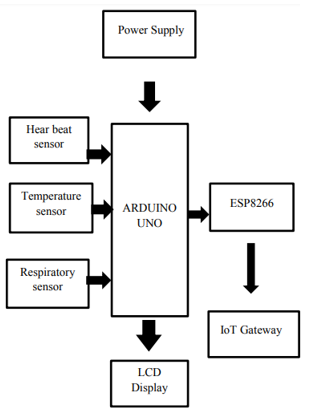Real-Time Analysis of Wearable Sensor Data Using IoT and Machine Learning in Healthcare
Keywords:
Patient monitoring system, controller, pulse rate sensor, temperature sensor, AR glasses, IoTAbstract
Practitioners in the medical field are always on the hunt for new tools that can improve their workflow. There have been several developments in the operating room as a result of the digital age's impact on the clinical environment. The purpose of this study is to reduce the likelihood of burnout while providing better treatment to patients. The LM35 and pulse sensor in the system measure the user's core body temperature, heart rate, and breathing rate. The Arduino UNO controller board communicates with each of these sensors. The WiFi module's data transmissions are tracked by use of AR glasses. Adafruit, an Internet of Things platform, stores sensor data reserved by the ESP8266 WiFi module. In this way, the medical history of the patients may be accessed whenever necessary. When the data from the sensors is too high, an alarm is sent to the surgeon. As a result, the prototype facilitates the doctor's ongoing monitoring of patient data.The use of IoT(Internet of Things) with Machine Learning can help use to solve this issue
Downloads
References
Egui Zhu1, Italo Masiello, Arash Hadadgar, Nabil Zaru 2014 on the title ”Augmented Reality in healthcare education:an integrative review” Department of Learning, Informatics, Management and Ethics (LIME) DOI:10.7717/peerj.469; Source: PubMed
Filip Malawski, 2018 AGH University, “Driver Assistance System Using Augmented Reality Headset,” IEEE Transactions on Electronics and Telecommunications, vol. 3, pp. 978-1-5386,
Siddhant Patil,Chiquitha Prabhu, Omka rNeogi, AbhijitR. Joshi, Neha Katre 2016,” E-learning system using Augmented Reality”, IEEE.DOI:10.1109/ICCUBEA.2016.7860038
Proniewska. K, Dołe¸ga-Dołe¸gowsk.D, and D. Dudek, 2018 ‘‘A holographic doctors’ assistant on the example of a wireless heart rate monitor,’’ Bio-Algorithms MedSyst., vol. 14, no. 2, pp. 1–5.
Afef Mdhaffar, Tarak Chaari , Kaouthar Larbi, Mohamed Jmaiel and Bernd Freisleben 2019 “IoT-based Health Monitoring via LoRaWAN”, IEEE EUROCON.Vol 8,Issue 12
Mohammad M. Masud, Mohamed Adel Serhani, and Alramzana Nujum Navaz 2015 “Resource-Aware Mobile Based Health Monitoring”, 2168-2194 (c) IEEE.vol 2, Issue 2
Ayush Bansal , Sunil Kumar, Anurag Bajpai, Vijay N.Tiwari, Mithun Nayak, Shankar Venkatesan, Rangavittal Narayanan,2016 “Remote health monitoring system for detecting cardiac disorders”, IET Syst. Biol., Vol. 9, Issue 6, pp. 309–314.
Hamid Al-Hamadi and Ing-Ray Chen, 2017 “TrustBased Decision Making for Health IoT Systems” DOI 10.1109 /JIOT.2018.2736446, IEEE Internet of Things Journal. Vol.4, Issue 5, pp (99):1-1
Salman Al-Nuaimi, M. A. ., & Abdu Ibrahim, A. . (2023). Analyzing and Detecting the De-Authentication Attack by Creating an Automated Scanner using Scapy. International Journal on Recent and Innovation Trends in Computing and Communication, 11(2), 131–137. https://doi.org/10.17762/ijritcc.v11i2.6137
S.Meivel, S.Charanyameenachi, D.supritha, S.G.Hamsaveni,2019 on title” E-Health Real-Time Monitoring System using IoT Sensor (ESKIN) Methodology International Journal of Engineering and Advanced Technology (IJEAT) ISSN: 2249 – 8958, Vol-8, Issue-3S,
Bhagya Lakshmi, M1 Hariharan ,R2 Udaya Sri, C3 Nandhini Devi, P4 Sowmiya “Heart Beat Detector using Infrared Pulse Sensor” IJSRD - International Journal for Scientific Research & Development| Vol. 3, Issue 09.
Dr.A.Sabanayagam, G.Anish Girija, 2017” DESIGN AND MODELING OF MOBILE HEALTH MONITORING SYSTEM”, International Journal of Innovations in Scientific and Engineering Research (IJISER),vol.4,no 2,pp.63-65.
Pallathadka, D. H. . (2021). Mining Restaurant Data to Assess Contributions and Margins Data . International Journal of New Practices in Management and Engineering, 10(03), 06–11. https://doi.org/10.17762/ijnpme.v10i03.128
M. Prakash, U. Gowshika, T. Ravichandran, 2016 “A Smart Device Integrated with an Android for Alerting a Person’s Health Condition: Internet of Things” Indian Journal of Science and Technology, Vol. 9 (6). [13] ] S. Wang et al 2017., ‘‘Augmented reality as a telemedicine platform for remote procedural training,’’ Sensors, vol. 17, no. 10, p. 2294.

Downloads
Published
How to Cite
Issue
Section
License

This work is licensed under a Creative Commons Attribution-ShareAlike 4.0 International License.
All papers should be submitted electronically. All submitted manuscripts must be original work that is not under submission at another journal or under consideration for publication in another form, such as a monograph or chapter of a book. Authors of submitted papers are obligated not to submit their paper for publication elsewhere until an editorial decision is rendered on their submission. Further, authors of accepted papers are prohibited from publishing the results in other publications that appear before the paper is published in the Journal unless they receive approval for doing so from the Editor-In-Chief.
IJISAE open access articles are licensed under a Creative Commons Attribution-ShareAlike 4.0 International License. This license lets the audience to give appropriate credit, provide a link to the license, and indicate if changes were made and if they remix, transform, or build upon the material, they must distribute contributions under the same license as the original.





